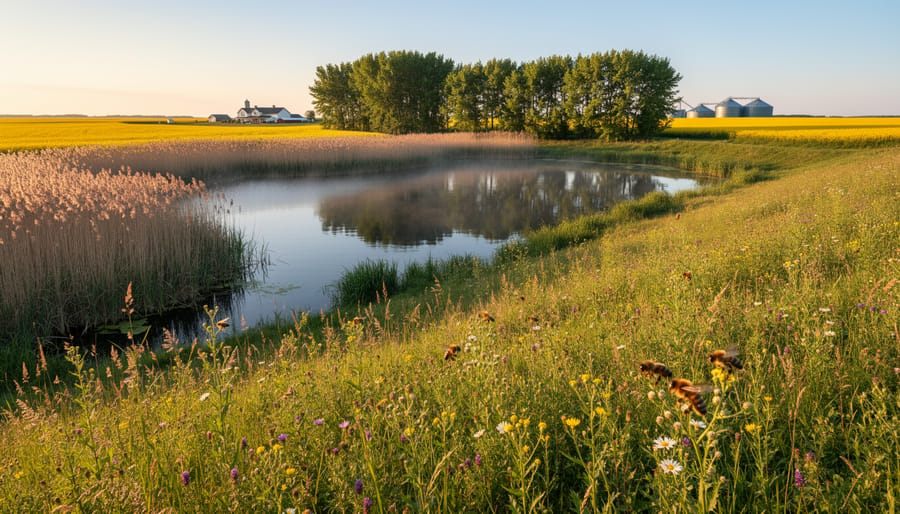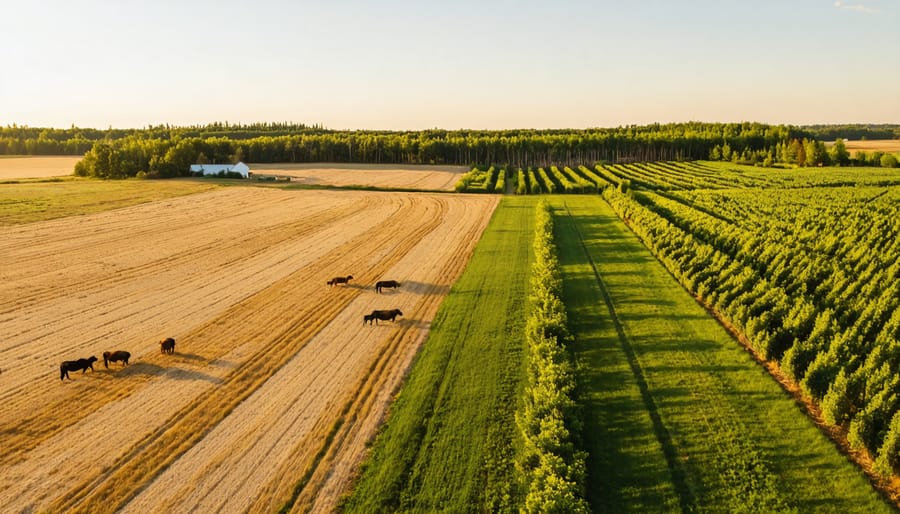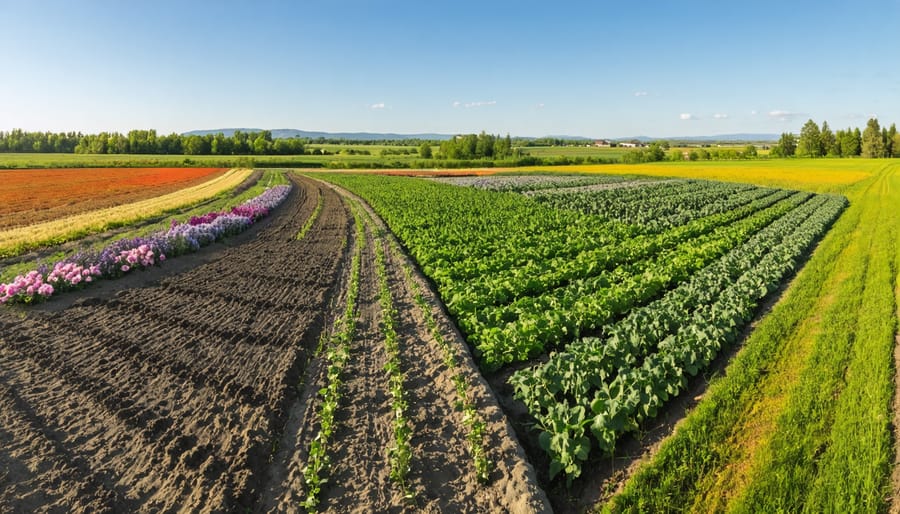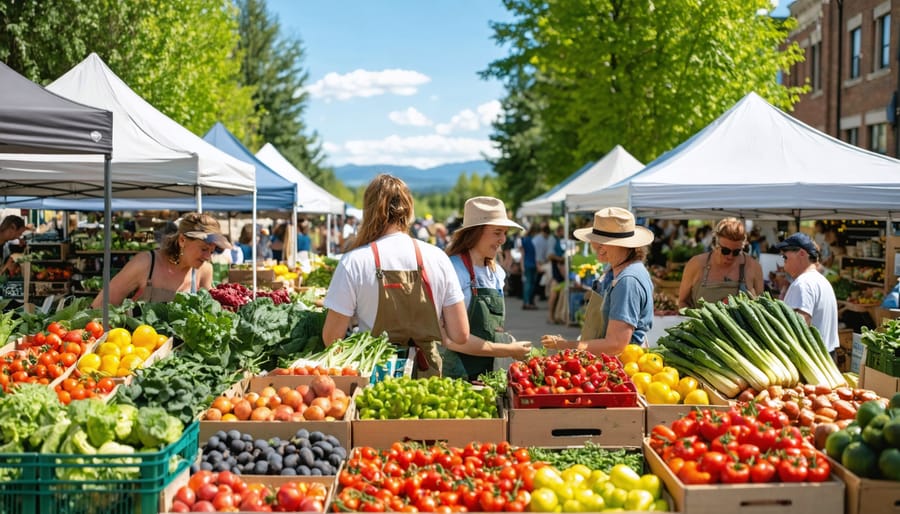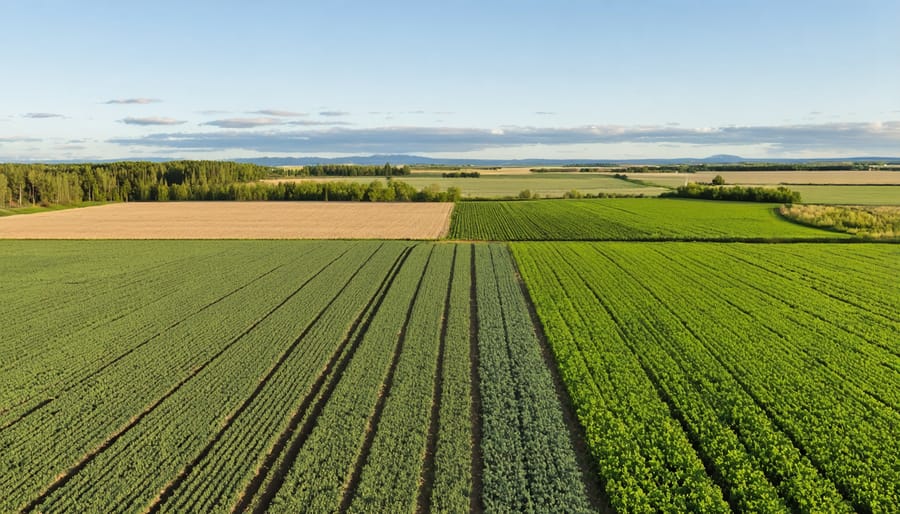In the heart of Alberta’s farming communities, a revolution in agricultural innovation is reshaping how we grow food, protect our soil, and sustain farm businesses. Precision agriculture technologies now enable farmers to reduce water usage by up to 30% through sensor-driven irrigation systems, while AI-powered drones map fields with centimeter-level accuracy to optimize crop yields. Smart farming practices, from vertical farming solutions yielding 400% more produce per square meter to regenerative soil management techniques, are transforming traditional operations into data-driven enterprises. Canadian farmers are pioneering these advancements, combining centuries-old wisdom with cutting-edge technology to create more resilient and profitable agricultural systems.
The integration of blockchain technology for supply chain transparency, mobile apps for real-time crop monitoring, and automated harvesting systems isn’t just improving efficiency—it’s revolutionizing how our farms operate. As climate challenges intensify and global food demand rises, these innovations offer practical solutions for Canadian farmers to maintain their position as world leaders in sustainable agriculture. Whether managing a family farm in southern Alberta or operating a large-scale operation in the prairie provinces, today’s agricultural innovations provide the tools needed to thrive in an evolving industry.
Digital Finance Tools Transforming Farm Management
Blockchain-Based Supply Chain Financing
Blockchain technology is revolutionizing how Alberta farmers manage their supply chain finances, creating unprecedented transparency and efficiency in agricultural transactions. As more producers focus on building greener supply chains, blockchain offers a secure and traceable system for managing financial flows.
The Prairie Grain Network, a blockchain initiative launched in Red Deer, demonstrates how this technology benefits local farmers. Participants can access better financing terms through transparent record-keeping of their grain transactions, storage, and delivery schedules. This digital ledger system allows financial institutions to assess risk more accurately and offer more competitive rates to farmers.
For example, Calgary-based farmer Sarah Thompson implemented blockchain tracking for her organic wheat operation and secured 15% better financing terms within six months. The system provides real-time verification of her sustainable farming practices, storage conditions, and delivery schedules, making her operation more attractive to lenders.
The technology also enables smart contracts, which automatically execute payments when predetermined conditions are met. This reduces payment delays and administrative burden, particularly beneficial during harvest season when cash flow is critical. Several Alberta credit unions now offer specialized blockchain-based financing programs, with some reporting a 40% reduction in processing time for agricultural loans.
For farmers interested in adopting blockchain technology, the Alberta Agricultural Financial Services Corporation offers free workshops and implementation support through their digital innovation program.

Smart Contracts for Equipment Leasing
Smart contract technology is revolutionizing equipment leasing in Alberta’s farming community, offering a secure and transparent way to access essential machinery without the burden of full ownership costs. These digital agreements, running on blockchain platforms, automatically execute predefined terms between equipment owners and farmers, streamlining the entire leasing process.
Calgary-based farmer Mark Thompson shares his experience: “Using smart contracts to lease my combine harvester has eliminated paperwork hassles and reduced my operational costs by 30%. The system automatically handles payments and maintenance schedules, letting me focus on what matters – growing crops.”
The technology works by creating self-executing contracts that trigger actions based on preset conditions. For example, when a farmer makes a payment, the smart contract automatically updates access permissions and maintenance schedules. This system also includes features like automated weather-based insurance payouts and usage-based pricing, making equipment leasing more flexible and affordable for seasonal operations.
Several agricultural cooperatives in Alberta have implemented smart contract platforms, reporting a 40% reduction in administrative costs and a 25% increase in equipment utilization rates. The system also enables equipment sharing among neighboring farms, fostering community collaboration while maximizing resource efficiency.
For farmers interested in exploring smart contract leasing, the Alberta Agricultural Technology Network offers free workshops and implementation support, helping bridge the gap between traditional farming practices and innovative financial solutions.
Green Financing Programs for Sustainable Agriculture
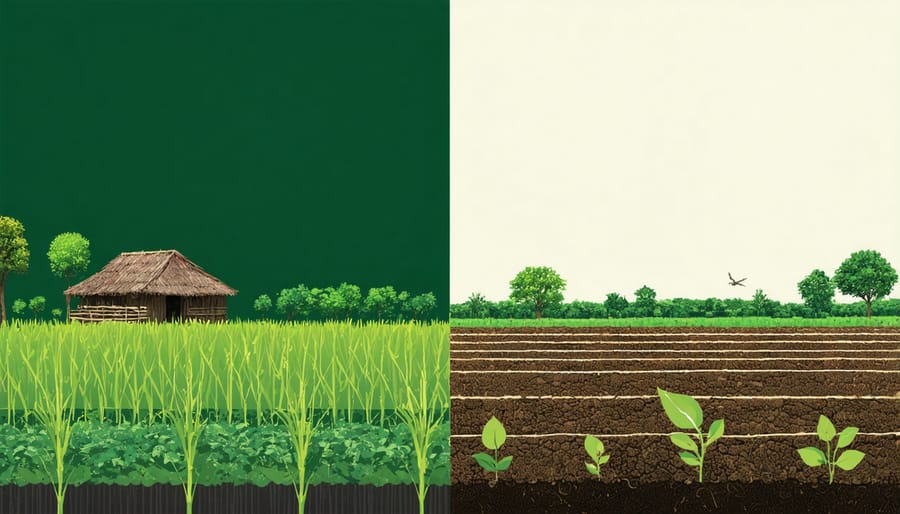
Carbon Credit Financing
Canadian farmers are discovering new revenue streams through monetizing carbon credits, turning sustainable farming practices into financial opportunities. Alberta’s Carbon Offset System has been particularly successful, allowing farmers to earn credits for practices like reduced tillage, improved nitrogen management, and enhanced grazing strategies.
The process begins with establishing a baseline of current carbon emissions and implementing verified carbon-reducing practices. For every tonne of carbon dioxide equivalent reduced or sequestered, farmers can earn one carbon credit. These credits can then be sold to industries looking to offset their emissions, typically ranging from $20 to $50 per tonne in the Canadian market.
Local success stories include the Brown family farm near Lethbridge, which earned $15,000 in their first year through no-till practices and cover cropping. Similarly, a collective of farmers in Red Deer County pooled their carbon credits through an aggregator, maximizing their market leverage and reducing administrative costs.
To participate, farmers need to:
– Document current farming practices
– Implement approved carbon reduction protocols
– Maintain detailed records
– Work with verified carbon credit aggregators
– Have practices verified by third-party auditors
The Alberta Carbon Registries provides support for farmers starting their carbon credit journey, offering resources and connecting them with qualified aggregators. While the initial paperwork may seem daunting, many farmers report that the long-term benefits extend beyond financial gains, including improved soil health and increased crop resilience.
Environmental Stewardship Incentives
Canadian farmers now have access to numerous financial incentives that reward sustainable farming practices, making environmental stewardship both ecologically and economically beneficial. The Environmental Farm Plan (EFP) program, particularly strong in Alberta, offers cost-sharing opportunities for farmers implementing water conservation measures, soil health improvements, and biodiversity protection strategies.
The Canadian Agricultural Partnership (CAP) provides grants of up to $50,000 for sustainable agriculture projects, including precision agriculture technology adoption and renewable energy installations. These funds help offset the initial costs of transitioning to more environmentally friendly farming methods while ensuring long-term profitability.
Carbon offset programs have gained significant traction, allowing farmers to earn credits for practices like no-till farming and cover cropping. In Alberta, the Carbon Offset System enables agricultural producers to generate additional revenue streams while sequestering carbon and improving soil health. Many farmers report earning between $15 and $30 per hectare through these programs.
Local conservation authorities also offer targeted funding for specific environmental initiatives. For instance, the ALUS (Alternative Land Use Services) program compensates farmers for converting marginally productive land into natural habitat, with annual payments ranging from $150 to $300 per acre.
Financial institutions are increasingly offering “green loans” with preferential interest rates for sustainable farming projects. Several credit unions in Alberta have developed specialized agricultural financing packages that reward documented environmental improvements with reduced borrowing costs.
Remember to check with your local agricultural extension office, as new programs are regularly introduced, and existing ones often update their criteria and benefit structures to better serve the farming community while promoting environmental sustainability.
Community-Based Financing Solutions
Cooperative Lending Models
Alberta’s farming communities are revolutionizing agricultural financing through innovative cooperative lending models that prioritize mutual support and sustainable growth. These farmer-led initiatives are transforming how capital flows within local food systems while building resilient agricultural networks.
The Prairie Farm Lending Circle, launched in Red Deer County, exemplifies this approach. Here, groups of 8-12 farmers pool resources to create a revolving loan fund, enabling members to access capital at below-market rates. Each participant contributes monthly, creating a sustainable funding source that has helped finance everything from equipment upgrades to organic certification costs.
Similarly, the Southern Alberta Agricultural Co-op has pioneered a unique risk-sharing model where established farms mentor and financially back newer operations. This program has achieved a 92% success rate in helping new farmers establish viable operations, compared to the provincial average of 65%.
Digital platforms are enhancing these cooperative models. The Alberta Farm Credit Network, a farmer-developed online platform, matches agricultural lenders with borrowers while maintaining the community-focused principles of traditional co-ops. This system has facilitated over $5 million in peer-to-peer lending since 2020, demonstrating how technology can amplify the impact of cooperative financing while preserving the personal connections that make these models successful.

Crowd-Funded Farm Projects
In recent years, Canadian farmers have discovered the power of community-supported financing, with several remarkable success stories emerging from Alberta’s agricultural landscape. The Mitchell Family Farm in Lacombe County successfully raised $75,000 through a local crowd-funding campaign to establish their regenerative grazing system, bringing together 150 community members who now receive seasonal meat shares.
Similarly, the Rainbow Collective Farm near Edmonton leveraged crowd-funding to secure $120,000 for their innovative greenhouse project, combining traditional farming methods with modern hydroponics. Their success demonstrates how digital platforms can connect farmers directly with community investors, creating sustainable funding models that benefit both parties.
Perhaps most inspiring is the story of the Prairie Heritage Seed Collective, which raised $200,000 from over 500 supporters to establish a seed-saving facility in central Alberta. This project not only preserved heritage grain varieties but also created a community-owned seed bank that serves local farmers.
These initiatives showcase how crowd-funding is transforming agricultural financing in Canada. Successful projects typically offer tangible benefits to supporters, such as harvest shares, farm-to-table experiences, or membership in CSA programs. For farmers considering this route, transparency and clear communication with supporters have proven essential, along with detailed project timelines and regular updates on farm developments.
The growing success of these projects indicates a shift in how Canadians view agricultural investment, creating stronger connections between urban supporters and rural farming communities.
Case Study: Alberta’s Pioneer Farmers
The Hanson family farm in Lacombe County stands as a testament to innovative agro-financing approaches in Alberta’s agricultural landscape. After three generations of conventional farming, Sarah Hanson and her brother Mike transformed their 800-hectare operation by implementing sustainable agroecology practices alongside creative financing solutions.
In 2018, the Hansons pioneered a community-supported agriculture (CSA) financing model, where local residents invest in the farm’s seasonal operations in exchange for regular produce deliveries. This approach generated $175,000 in upfront capital, enabling them to transition 200 hectares to organic production without taking on traditional bank loans.
The family also established partnerships with three local restaurants, securing advance purchase agreements that provided stable income streams and reduced market uncertainties. These partnerships helped finance the installation of smart irrigation systems and soil monitoring technology, resulting in a 30% reduction in water usage and a 25% increase in crop yields within two years.
The Hansons’ innovative approach included participating in Alberta’s Environmental Farm Plan program, which provided matching grants for sustainable infrastructure improvements. They leveraged these funds to install solar panels, reducing energy costs by 40% and creating an additional revenue stream through power grid contributions.
Their success has inspired neighbouring farms to adopt similar models. The Hanson farm now hosts monthly workshops sharing their experiences with other Alberta farmers, emphasizing practical implementation strategies and financial planning techniques. Their story demonstrates how combining traditional farming wisdom with modern financing solutions can create resilient and profitable agricultural enterprises.
Today, the farm’s diversified income streams, including CSA memberships, restaurant partnerships, and renewable energy credits, have increased their annual revenue by 45% compared to their previous conventional farming model, while significantly reducing their dependence on traditional agricultural loans.
As we look to the future of agricultural financing in Canada, the innovations we’ve explored represent more than just technological advancement – they embody a fundamental shift toward sustainable farming practices that benefit both our environment and farming communities. The integration of digital lending platforms, sustainable certification programs, and community-supported agriculture models has created a robust framework for financial success in modern farming.
Alberta farmers are increasingly finding success by combining traditional agricultural knowledge with innovative financing solutions. The growing network of support from local credit unions, government initiatives, and private investors demonstrates the strong foundation being built for sustainable agriculture across the province.
Looking ahead, we can expect to see further developments in precision agriculture financing, blockchain-based supply chain solutions, and expanded carbon credit programs. These innovations will likely create new revenue streams and financing opportunities for farmers committed to sustainable practices.
For producers considering the transition to more sustainable methods, the time has never been better. With increasing consumer demand for environmentally responsible food production and growing financial incentives for sustainable practices, the path forward is clear. The key to success lies in staying informed about new financing options, connecting with local agricultural networks, and taking calculated steps toward implementing these innovations.
By embracing these sustainable agro-financing solutions, Canadian farmers are not just securing their own financial future – they’re contributing to a more resilient and sustainable agricultural sector for generations to come.


